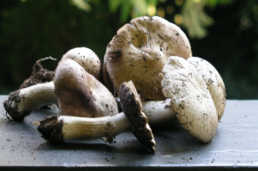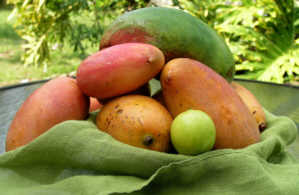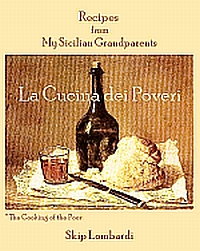Florida Foraging 101
August 9th, 2007
We’re not new to foraging. Back in Connecticut, we found (but kept silent about) a few neighborhood glens where mushrooms spring up after an autumnal rain. At first, we found mostly puffballs and campesters (the wild version of the button mushrooms in every supermarket). Once in a while we collected something that looked like porcini (aka boletus edulis), but were not always 100% sure. And because the margin of error in mushroom identification is slim, we had our share of anxiety until we bought a graphically precise mushroom field guide and met a veteran forager (who, thanks to his Polish DNA, is programmed to hunt for fungi after Labor Day). Soon enough, we were gathering enough mushrooms for a proper dish of pasta alla boscaiola, woodsman’s-style pasta. It was delicious. We felt we had put the ‘bosca’ back in boscaiola.
But since we’ve lived in Sarasota, we’ve been more mycologically challenged. We showed a couple of specimens to a friend who works at Selby Gardens. He studied our find through his loupe and muttered something about pores rather than gills without making a judgement; this did little to bolster our confidence. Needless to say, we changed our dinner plans.
Our fruit foraging has been more productive. Unlike virtually all our neighbors, we don’t own a dog. But whenever we go out for an evening stroll we bring a plastic bag, just in case something delicious has tumbled down to the side of the street. Surinam cherries, loquats, white sapote, calomondins…all edible—and ignored—in our vegetation-blessed neighborhood. Our only competition for this bounty are the local squirrels and less savory fruit rats. Beating them at their game adds a certain frisson to an already pleasant walk.
Certainly oranges have been easy enough to acquire. Even though our own back yard is home to several citrus trees, we do supplement our harvest with occasional evening forays. This is often necessary because the squirrels awaken before us and seem to enjoy starting their day with fresh OJ as much as we do.
One member of this partnership has proposed a rodent resettlement initiative. This would involve a couple of Haveahart traps and an evening drive “out east of I-75.” The plan has not gained unanimous support in our household legislature, so the proposal may have to be reintroduced during the fall fruit session; in any event, our next crop of oranges won’t ripen until November.
On the other hand, grapefruit are abundant for two reasons: 1) Most grapefruit are too large to be hauled off even by the most optimistic squirrel, and 2) half of Sarasota seems to be on Lipitor ®, for which grapefruit consumption is contraindicated.
If you follow food trends, you know that Alice Waters and her chefs at Chez Panisse have put the Meyer lemon on a culinary pedestal. It’s with good reason that this exceptionally juicy and fragrant citrus of low acidity is so prized, and we were thrilled to discover an old Meyer lemon tree on one of our trade routes. On the edge of a lot where a house was to be leveled, it was laden with fruit last year. We were looking forward to another lemon season, and it never occcured to us that after knocking over the house, the developer would also bulldoze every tree on the property! We’re still in mourning.

Mango season is in full swing now, and again, we’re astounded that so much fruit is simply lying on the ground. We found one mango that weighed nearly three pounds and dozens of others in the 14-oz. range. Here again, we are in competition with local wildlife. But caveat, fellow foragers! We won’t gorge ourselves on mangoes the way we did last year. One of us is allergic to poison ivy and found that excessive mango intake can trigger an itchy rash—not as discomfitting as poison ivy—but enough to make us look up the botanical family of Anacardiaceae, whose members include cashew, poison ivy, and…mangoes.
Exercising some restraint, we’ve been enjoying mangoes as a simple breakfast salsa. We wash our mangoes and then skin them with a carrot-peeler. We then rinse both the fruit and our hands—the resin from the skin contains most of the chemical allergens. Having cut the flesh into small chunks, we mix it with a little salt, freshly milled black pepper, red pepper flakes, juice from foraged limes, and coarsely chopped Thai basil. That, with some whole-grain toast, is a beautiful breakfast. We sometimes add grated ginger root and lime rind—but the mangoes are so delicious right now that we don’t have to do much.



